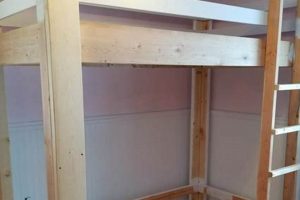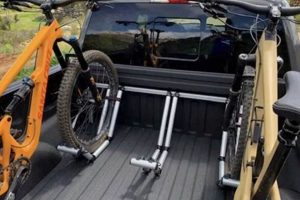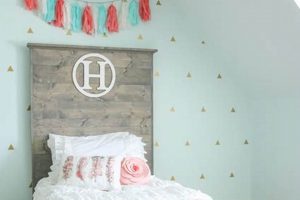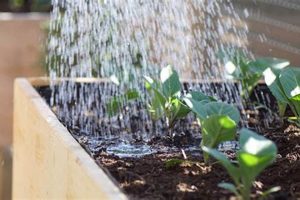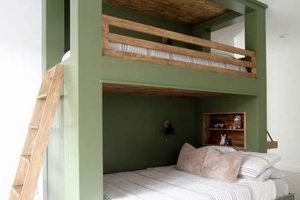The phrase identifies a category of do-it-yourself projects centered on constructing protective structures for elevated garden beds. These structures serve various purposes, including extending the growing season, protecting plants from pests and adverse weather conditions, and improving overall crop yields. As an example, constructing a simple wooden frame covered with clear plastic sheeting to shield vegetables from frost would fall under this category.
Creating such covers offers multiple advantages. Season extension allows gardeners to cultivate crops earlier in the spring and later into the fall. Physical barriers deter pests like insects and small animals, reducing the need for pesticides. Protection from harsh weather, such as heavy rain, hail, or excessive sun, minimizes plant stress and damage. Historically, gardeners have employed various methods to protect their crops, ranging from simple cloches to more elaborate cold frames. Modern approaches often incorporate readily available materials and adaptable designs.
Subsequent sections will explore different types of protective structures, including cold frames, row covers, and hoop houses. Detailed instructions and material lists will be provided for constructing various designs, catering to diverse needs and skill levels. Considerations for material selection, structural integrity, and ventilation will also be addressed.
Construction Considerations for Protective Garden Bed Structures
Successful implementation of protective structures for elevated garden beds requires careful planning and execution. The following tips offer guidance on key aspects of design and construction.
Tip 1: Accurate Measurement and Planning: Prior to commencing construction, precisely measure the raised bed dimensions. This ensures a snug and effective fit for the cover, preventing gaps that could compromise protection.
Tip 2: Appropriate Material Selection: Choose materials based on durability, light transmission, and cost-effectiveness. Polyethylene film offers affordability, while polycarbonate provides enhanced durability and light diffusion. Wood selections should be rot-resistant.
Tip 3: Structural Integrity and Support: Design the framework to withstand anticipated wind loads and snow accumulation. Reinforce joints and utilize appropriate fasteners to maintain structural stability.
Tip 4: Adequate Ventilation: Incorporate ventilation mechanisms to prevent overheating and moisture buildup within the covered structure. Hinged panels or adjustable vents provide control over airflow.
Tip 5: Pest Exclusion Strategies: Utilize fine mesh netting or row covers in conjunction with the primary structure to prevent insect entry. Secure edges to the ground to eliminate access points.
Tip 6: Ease of Access and Maintenance: Design the structure for convenient access to plants for watering, weeding, and harvesting. Consider hinged sections or removable panels.
Tip 7: Drainage Considerations: Ensure proper drainage to prevent water accumulation inside the covered area, which can lead to fungal diseases. Sloping the cover slightly can aid water runoff.
Constructing durable and effective protective structures necessitates meticulous attention to detail. Proper planning, material selection, and construction techniques will significantly enhance the success of the endeavor.
The final section will summarize the benefits and further resources.
1. Material Selection
Material selection is a foundational element within the realm of do-it-yourself protective structures for elevated garden beds. The decision regarding which materials to employ directly influences the structure’s durability, functionality, and cost-effectiveness. Inadequate material selection can lead to premature structural failure, ineffective protection against environmental factors, and ultimately, a waste of resources. For example, utilizing untreated lumber for a frame in a humid climate will likely result in rot and collapse within a short period, negating any potential benefits the cover might have initially provided.
Conversely, judicious material selection enhances the long-term viability and performance of the protective structure. The choice between polyethylene film and polycarbonate panels for glazing significantly affects light transmission, insulation, and resistance to impact. Similarly, the selection of frame materials, such as treated lumber, metal conduit, or PVC piping, dictates the structure’s ability to withstand wind and snow loads. A carefully constructed hoop house using UV-resistant polyethylene film and galvanized steel hoops demonstrates the benefits of thoughtful material selection in extending the growing season and protecting plants from frost.
Therefore, a thorough understanding of material properties, environmental conditions, and budgetary constraints is paramount. Selecting the correct materials, given these factors, leads to a robust and efficient raised bed cover, providing optimal protection and maximizing the return on investment. Ignoring this critical aspect will inevitably compromise the integrity and effectiveness of the entire endeavor, resulting in a less-than-satisfactory outcome. The practical significance of this understanding is clear; it dictates the success or failure of the protective structure’s intended purpose.
2. Frame Construction
Frame construction represents a critical phase in the creation of protective structures for elevated garden beds. The structural framework dictates the cover’s overall stability, durability, and ability to withstand environmental stresses. A well-executed framework ensures that the covering material is adequately supported and that the structure can effectively protect the plants within.
- Material Selection and Load Bearing Capacity
The choice of framing materials directly impacts the load-bearing capacity of the structure. Wood, metal, and PVC each offer distinct advantages and disadvantages in terms of strength, weight, and cost. Selecting a material inappropriate for the anticipated snow or wind loads can lead to structural failure. For example, a lightweight PVC frame may not be suitable for regions with heavy snowfall, potentially resulting in collapse and damage to plants.
- Joint Design and Structural Integrity
The method of joining frame components is crucial for maintaining structural integrity. Weak or poorly executed joints can compromise the entire framework’s stability. Screws, bolts, and specialized connectors provide robust connections compared to adhesives alone. A frame utilizing reinforced joints and cross-bracing is better equipped to withstand external forces. Consider a mortise and tenon joint in a wooden frame or welded connections in a metal frame, which offers enhanced strength and durability.
- Anchoring and Ground Stability
Securely anchoring the frame to the raised bed or the ground is essential to prevent it from being displaced by wind or other external forces. Anchoring methods vary depending on the frame material and soil conditions. Stakes, brackets, or concrete footings can provide a stable foundation. A frame that is inadequately anchored is vulnerable to being blown over, exposing plants to the elements.
- Design and Accessibility
The frame’s design impacts the ease of access to the plants within. Hinged sections, removable panels, or tunnel-like structures facilitate planting, watering, and harvesting. A well-designed frame considers both structural stability and user accessibility, balancing protection with convenience.
The careful consideration of materials, joint design, anchoring, and accessibility is paramount in frame construction for protective structures. A robust and well-engineered framework is not only essential for safeguarding plants but also ensures the longevity and effectiveness of the overall system. The framework directly supports the success and long-term sustainability.
3. Ventilation design
Ventilation design constitutes an indispensable element within the context of DIY raised bed covers. The efficacy of any protective structure hinges significantly on its ability to regulate internal temperature and humidity levels. A poorly ventilated enclosure can engender conditions conducive to fungal diseases and inhibit plant growth, thereby negating the intended benefits of the cover. The causal relationship is straightforward: inadequate ventilation precipitates increased humidity and elevated temperatures, fostering an environment ripe for pathogens and physiological stress in plants. An example of this phenomenon is the rapid spread of powdery mildew in a greenhouse-like structure lacking sufficient airflow.
Effective ventilation design, conversely, mitigates these risks. By facilitating air exchange, it helps maintain optimal temperature and humidity levels, promoting healthy plant development and reducing the incidence of disease. This can be achieved through various mechanisms, including adjustable vents, strategically placed openings, or automated fan systems. A practical example is the integration of hinged roof panels in a cold frame, allowing gardeners to manually adjust ventilation based on prevailing weather conditions. The strategic placement of mesh-covered openings to promote cross-ventilation also addresses this concern in many raised bed cover designs.
In summary, ventilation design is not merely an ancillary consideration but rather a fundamental component of successful DIY raised bed covers. Its proper implementation is essential for creating a protected environment that fosters plant health and productivity. The challenges inherent in balancing heat retention and ventilation require careful planning and execution, but the rewards of a well-ventilated structure are substantial, contributing significantly to the overall success of the gardening endeavor. The failure to prioritize ventilation represents a critical oversight, undermining the potential benefits of any protective cover, regardless of its construction or materials.
4. Pest exclusion
Pest exclusion is a primary function of protective structures constructed for raised garden beds. The objective is to create a physical barrier that prevents unwanted insects, animals, and other pests from accessing and damaging crops. Effective pest management through physical barriers is crucial for minimizing reliance on chemical interventions and promoting sustainable gardening practices.
- Physical Barriers and Mesh Selection
The most direct approach to pest exclusion involves creating a physical barrier using netting, screening, or solid materials. The selection of mesh size is critical; it must be fine enough to exclude the target pests while allowing adequate airflow and sunlight penetration. For example, fine insect netting effectively deters aphids and whiteflies, while larger mesh can exclude birds and larger insects. The material’s durability and UV resistance also influence its long-term effectiveness.
- Sealing and Entry Point Management
The effectiveness of any pest exclusion system hinges on its ability to create a complete seal around the raised bed. Gaps or openings, however small, can provide entry points for pests. Securing the edges of netting or screening to the raised bed frame or ground is crucial. Burying the edges or using clips and fasteners can prevent pests from burrowing underneath the barrier. Regular inspection and maintenance are necessary to identify and seal any breaches in the barrier.
- Crop-Specific Considerations
The type of crops being grown influences the pest exclusion strategies. Some plants are more susceptible to certain pests than others. For example, brassicas like cabbage and broccoli are particularly vulnerable to cabbage moths and cabbage white butterflies, necessitating the use of fine mesh netting during the growing season. Understanding the specific pest pressures for each crop allows for targeted exclusion strategies.
- Integrated Pest Management (IPM) and Cultural Practices
Pest exclusion is most effective when integrated with other pest management practices. Crop rotation, companion planting, and the introduction of beneficial insects can further reduce pest pressure. Good sanitation practices, such as removing crop debris and weeds, eliminate potential pest breeding grounds. An integrated approach combines physical barriers with cultural practices to create a resilient and sustainable gardening system.
Pest exclusion, therefore, represents a cornerstone of effective raised bed gardening. By creating a physical barrier and integrating it with other pest management strategies, gardeners can minimize crop damage, reduce reliance on chemical interventions, and promote healthy plant growth. The success of a DIY raised bed cover often depends on its ability to effectively exclude pests, thereby enhancing overall yield and garden sustainability.
5. Season extension
Extending the growing season represents a primary motivator for constructing protective structures for elevated garden beds. The ability to cultivate crops beyond the typical frost-free period significantly enhances productivity and broadens the range of plants that can be successfully grown in a given climate. This outcome directly correlates with the design and implementation of appropriate coverings.
- Frost Protection and Temperature Regulation
Protective coverings mitigate the impact of frost and low temperatures, enabling earlier planting in spring and later harvesting in fall. The degree of protection afforded depends on the insulation properties of the covering material and the structural design. For instance, a cold frame constructed with double-walled polycarbonate provides greater insulation than a simple row cover, thus extending the growing season further into colder periods. Row covers, while less insulating, provide some protection against light frosts, allowing for earlier germination of cool-season crops.
- Microclimate Creation and Accelerated Growth
Protective structures create a microclimate that is warmer and more humid than the surrounding environment. This accelerated growth can shorten the time to harvest, enabling gardeners to produce multiple crops within a single season. For example, seedlings started under a protective cover can be transplanted outdoors earlier, giving them a head start and extending the overall growing period. The enclosed environment can also protect plants from strong winds and excessive rainfall, further promoting growth.
- Extending the Harvest Window
The employment of protective structures facilitates the continuation of harvesting certain crops beyond their typical seasonal limitations. For example, leafy greens can be harvested throughout the winter months in regions with mild climates when grown within a cold frame or hoop house. Similarly, late-season tomatoes can be protected from early frosts, allowing them to ripen fully and extend the harvest window. The ability to harvest crops for a longer period increases overall yield and provides a continuous supply of fresh produce.
- Crop Diversification
Extending the growing season through the use of protective structures enables the cultivation of crops that would otherwise be unsuitable for a particular climate. For instance, heat-loving plants like peppers and eggplants can be successfully grown in cooler regions by starting them indoors under protective covers and transplanting them outdoors once the weather warms. Similarly, tender herbs can be protected from frost, allowing them to be grown year-round. This diversification enhances the range of crops that can be grown and improves overall garden resilience.
In summary, the connection between season extension and the construction of protective coverings for raised garden beds is multifaceted and directly related to the optimization of plant growth and productivity. Protective structures create favorable microclimates, protect plants from frost, and enable the cultivation of a wider range of crops over a longer period, thereby maximizing the benefits of gardening in diverse climates.
6. Weather protection
The primary purpose of raised bed covers, particularly in the context of do-it-yourself construction, centers on weather protection. These structures shield plants from a variety of adverse climatic conditions, including heavy rainfall, intense sunlight, strong winds, hail, and frost. The impact of such conditions, if unchecked, can range from physical damage to plant tissues and soil erosion to complete crop failure. Therefore, weather protection functions as a critical determinant of plant health and yield in exposed environments. For instance, a simple hoop house constructed from PVC pipes and polyethylene film can effectively shield delicate seedlings from damaging hail, preventing the need for replanting and ensuring the continuity of the growing cycle.
The effectiveness of weather protection offered by a constructed raised bed cover depends significantly on its design and materials. Solid coverings provide robust protection against heavy rain and hail, but may also reduce light transmission and necessitate careful ventilation management to prevent overheating. Netting or mesh covers offer protection from wind and some degree of sun scorch, while still allowing for adequate air circulation and light penetration. The choice of covering material must, therefore, be aligned with the specific climatic challenges prevalent in the growing region. A raised bed cover incorporating adjustable side panels can offer a versatile solution, allowing for variable levels of protection based on prevailing weather conditions. Such a design can be closed during periods of intense wind or rain and opened during milder conditions to promote air circulation and prevent overheating.
In summary, weather protection is a crucial function of do-it-yourself raised bed covers. The selection of appropriate materials and design considerations directly affects the degree of protection afforded to plants. Understanding the specific climatic challenges faced by crops and tailoring the cover design accordingly is essential for maximizing the benefits of raised bed gardening. By providing effective weather protection, these structures enable gardeners to extend the growing season, improve crop yields, and cultivate a wider range of plant species, thereby enhancing overall food security and garden sustainability. The absence of adequate weather protection will likely lead to compromised plant health and reduced productivity, irrespective of other inputs.
7. Cost effectiveness
Cost effectiveness is a central consideration in the construction of protective structures for raised garden beds. The allocation of financial resources must align with the anticipated benefits, ensuring that the investment yields a tangible return in terms of increased yield, extended growing season, or reduced pest damage.
- Material Sourcing and Budget Constraints
The selection of materials significantly influences the overall cost of the project. Reclaimed lumber, repurposed materials, and locally sourced options can substantially reduce expenses compared to purchasing new, commercially available products. Balancing durability and affordability requires careful consideration of budget limitations and the long-term performance expectations of the structure. For instance, utilizing recycled plastic sheeting as a covering material presents a cost-effective alternative to more expensive polycarbonate panels, albeit with a trade-off in durability and light transmission.
- Design Simplicity and Labor Input
Complex designs often necessitate specialized tools, extensive labor, and increased material costs. Simpler designs, utilizing readily available materials and straightforward construction techniques, minimize these expenses. A basic A-frame cover constructed from lumber and clear plastic offers a cost-effective solution for frost protection, requiring minimal expertise and time investment. Evaluating the balance between design complexity and labor input is crucial for maximizing cost effectiveness.
- Long-Term Durability and Maintenance Costs
While initial cost is a primary consideration, long-term durability and maintenance expenses also factor into the overall cost effectiveness of a protective structure. Selecting durable materials and employing sound construction practices reduces the need for frequent repairs or replacements, thereby minimizing long-term expenses. Treating wooden components with preservatives or utilizing UV-resistant plastics can extend the lifespan of the cover and reduce maintenance requirements. A cost-benefit analysis should consider both initial investment and anticipated long-term expenses.
- Quantifiable Benefits and Return on Investment
Assessing the quantifiable benefits derived from the protective structure is essential for determining its cost effectiveness. Increased crop yields, extended growing season, and reduced pest damage can be translated into monetary values, allowing for a calculation of the return on investment. Monitoring crop production, tracking maintenance expenses, and comparing yields with and without the protective structure provides data for a comprehensive cost-benefit analysis. Demonstrating a tangible return on investment justifies the expenditure and validates the cost effectiveness of the project.
The integration of cost-effective strategies into the design and construction of raised bed covers ensures that resources are allocated efficiently and that the investment yields tangible benefits. Balancing material costs, design complexity, durability, and quantifiable benefits is crucial for maximizing the return on investment and promoting sustainable gardening practices.
Frequently Asked Questions
The following addresses common inquiries regarding the design, construction, and utilization of do-it-yourself protective structures for elevated garden beds.
Question 1: What materials are most suitable for constructing a frame for a raised bed cover?
The selection depends on budget, desired durability, and aesthetic preferences. Treated lumber offers a balance of cost and longevity, while metal conduit provides strength and weather resistance. PVC piping presents a lightweight and affordable option, but may lack structural rigidity in certain applications.
Question 2: How is adequate ventilation ensured within a covered raised bed?
Ventilation can be achieved through the strategic placement of vents, hinged panels, or adjustable openings. The size and number of these openings should be adjusted based on weather conditions to prevent overheating and moisture buildup.
Question 3: What is the most effective method for preventing pests from accessing a raised bed under cover?
The use of fine mesh netting or row covers, secured tightly to the frame and buried at the edges, presents an effective barrier. Regular inspection is essential to identify and repair any breaches in the protective structure.
Question 4: How does a raised bed cover extend the growing season?
By providing insulation and protection from frost, the cover allows for earlier planting in spring and later harvesting in the fall. This extended growing period enables the cultivation of crops that would otherwise be unsuitable for the local climate.
Question 5: What considerations are relevant when selecting a covering material for a raised bed?
Factors include light transmission, insulation properties, durability, and cost. Polyethylene film is an affordable option for temporary protection, while polycarbonate offers greater durability and improved light diffusion. UV resistance is crucial for extending the lifespan of the material.
Question 6: How can the structural integrity of a raised bed cover be maximized?
Employing robust construction techniques, reinforcing joints, and anchoring the frame securely to the ground or raised bed are crucial. The design should account for anticipated wind loads and snow accumulation, selecting materials and construction methods appropriate for these conditions.
Effective utilization of constructed raised bed covers necessitates a comprehensive understanding of materials, design principles, and environmental considerations.
The subsequent section provides resources for further investigation.
Conclusion
The preceding exploration of raised bed covers diy has emphasized the multifaceted nature of this endeavor. From material selection and frame construction to ventilation design and pest exclusion, each element contributes to the overall effectiveness of the protective structure. The economic considerations and potential for extended growing seasons further underscore the value of carefully planned and executed projects in this domain. A failure to address any one of these critical aspects can compromise the success of the entire effort.
The knowledge presented herein serves as a foundation for informed decision-making. The responsible application of these principles will contribute to more sustainable and productive gardening practices. Further investigation and adaptation to specific local conditions remain essential for optimizing the benefits derived from raised bed covers diy. The enduring pursuit of improved techniques will continue to yield advancements in horticultural practices and resource management.


